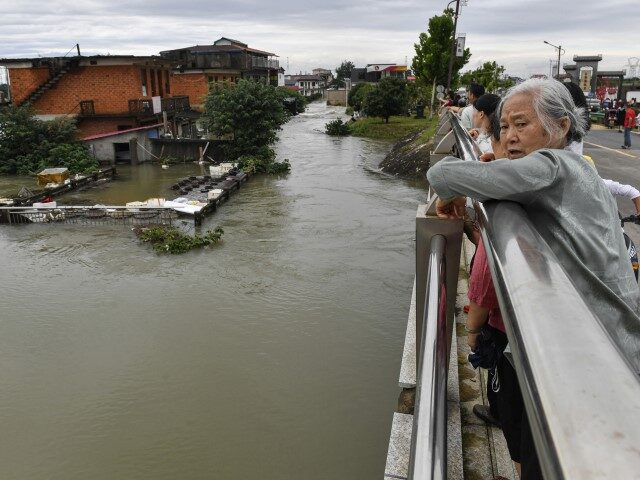Thousands Evacuated, Crops Threatened as Summer Floods Submerge East China
 STRINGER/AFP via Getty
STRINGER/AFP via Getty
China’s eastern heartland is facing massive floods affecting hundreds of thousands of people, triggering an emergency declaration in Jiangxi province on Wednesday and threatening to severely diminish the yield of the region’s rice crops.
Reports from Chinese state media and independent outlets identify Jiangxi and neighboring Hunan as the most affected provinces by the flooding so far this week. In Hunan, the Miluo River, a tributary of the Xiang River, documented its highest water levels since 1954 on Tuesday, leaving much of the city of Yueyang underwater. The state-run Global Times propaganda outlet reported that state-approved journalists in Pingjiang, a county of over 1 million people in Yueyang, were trapped in their writing offices and stayed behind to document the aftermath of the disaster.
The Global Times quoted a local who said that lower-lying areas in Pingjiang were “submerged up to the roof” as of Tuesday and the area was largely left without electricity. The local, identified only as “Song,” described Pingjiang as an impoverished area for much of its history, though the Communist Party claimed to have eradicated poverty in 2020.
The Hong Kong-based South China Morning Post reported on Tuesday that the flooding in Pingjiang appears worse than in other parts of Hunan because a dike burst in the area, sending water rushing into residential neighborhoods.
“One-third of Pingjiang’s old town and half of its new town is under water, provincial newspaper Hunan Daily reported,” according to the Morning Post. “Floodwater in some areas was said to be as high as 3 metres.”
The Chinese outlet Sixth Tone quoted local humanitarian workers in Pingjiang on Wednesday stating that many of those evacuated have yet to return home even as waters begin to slowly recede, and others trapped in their homes remain inaccessible. One worker thanked Chinese nationals from other parts of the country for sending basic supplies such as bottled water and candles, but stated that the region is still running dangerously low on some food supplies.
Sixth Tone noted that the Chinese government has yet to document any casualties despite the apparent severity of the natural disaster.
Chinese state media suggested that it expects the disaster to move east from Hunan to Jiangxi and Anhui provinces in the near future and that the Yangtze and several other local rivers are expected to begin overflowing as the rain continues.
“Affected by persistent heavy rainfall, it is expected that water levels of the middle and lower reaches of the Yangtze River, Poyang Lake and Dongting Lake will continue to rise,” the state-run Xinhua News Agency reported on Wednesday. “The water level of Taihu Lake will remain above its warning mark.”
Central China is home to some of the most important farmlands in the country. The Morning Post warned on Wednesday that farmers are reporting some signs that early season heavy rainfall is affecting rice cultivation, potentially destroying some expected yield during the harvest season.
“The crop … is sprouting prematurely in the southern and eastern areas of the country after heavy rains that have persisted since mid-June,” the newspaper reported, citing farmers in the region.
One farmer in Hunan, identified as Ding Yong, lamented that lower rice yields in 2024 were “almost certain” due to the “unusual” amounts of rain.
China regularly sees disastrous floods in the center of the country between June and August, exacerbated by poor infrastructure and attempts by the Communist Party to divert water to poorer areas and protect the homes of regime elites. Genocidal dictator Xi Jinping left the country this week, tasking Premier Li Qiang to visit Jiangxi on Monday.
“Li emphasized that currently it is the peak flood season, and flood prevention has entered a critical stage” during his visit, according to the Global Times. “It is necessary to further strengthen risk awareness and bottom-line thinking,” he reportedly said. The Global Times did not offer any specifics regarding what “bottom-line thinking” needed strengthening, according to Xi’s premier.
Xi is at press time in Kazakhstan meeting with Central Asian leaders.
Floods in eastern China caused significant social unrest in 2023 in Hebei province, an area located just outside of Beijing, as locals accused the government of redirecting floodwater flows to protect the elites in the capital. Ni Yuefeng, the head of the Communist Party in Hebei province, fueled that sentiment by publishing a message to residents in the heavily flooded city of Zhuozhou telling them to “resolutely serve as a moat for the capital.”
Videos leaking to social media outside of China showed locals in Hebei attacking Communist Party officials they accused of attempting to redirect floodwaters to target their homes, ousting them from some neighborhoods.
“Video clips of scuffles, lengthy altercations and clashes with police have emerged on social media in recent days,” Radio Free Asia (RFA) documented at the time, “showing embattled rural residents facing off with officials who want to flood their homes and farmland to protect Beijing, as well as ruling Chinese Communist Party leader Xi Jinping’s pet project — Xiong’an New Area.”
The Xiong’an New Area is a planned, but yet to be built, city in the region.
Follow Frances Martel on Facebook and Twitter.
Source link

